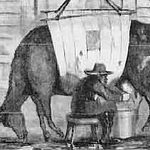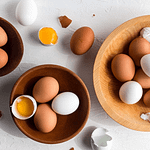Whether you like sweet, sour, or tangy, fruit spreads remain one of the most important items on our breakfast tables, and yet who knows how these tasty toast toppers made their way from fields and vines to our pantries? Today’s episode answers a question posed by As We Eat superfan Ramona Gibson: what is the difference between fruit jam, jelly, marmalade, and preserves?
The Sweet Story of Fruit Spreads
The story of fruit spreads and how they become staples of the breakfast table is as much about the similarities between fruit and techniques to preserve it as the story is of its differences. In today’s episode, we briefly revisit the origins of food preservation to show how the fundamental desire to be able to revisit the taste of fresh, sweet strawberries has led to the proliferation of all manners of jam, jellies, preserves, and more to our breakfast tables. We also explore how dishes revered by royalty - and whose costly ingredients were only affordable to those of an elevated class - made their way generously to breakfast tables across Great Britain and beyond.
Difference Between Jams, Jellies, and Marmalades
At first blush, it’s fairly easy to differentiate between the two most basic forms of preserved fruit spreads: jelly and jam. Jelly is made from juices while jam contains chopped or crushed fruits. Further examination of the composition of marmalades, conserves, preserves, curds, and fruit butters reveal additional similarities and differences regarding ratios of fruit to sugar and pectin.
But behind the sweet taste of strawberries, grapes, or orange come stories of how the science of food preservation made fruit spreads a household staple. In today’s episode of As We Eat, Leigh and Kim look beyond the definitions of jam, jelly, marmalade, conserves, preserves, curd, and fruit butter to discover how fruit spreads have deeply impacted and impressed our palates.
Sweet Spread Lore
Leigh discovered that Jean D’Arc ate quince preserves for courage before battle, that Nostradamus’ writings include recipes for cherry jam and pear preserves, and that Louis XIV required dishes of jam to be served as his royal table. Readily available supplies of sugar and proven food preservation techniques brought fruit spreads from the aristocratic tables to those of the working class. To this day, Western Europe remains the world’s greatest producer and consumer of fruit spreads. Taste for this breakfast treat crossed the Atlantic to the United States with its bounty of flavorful berries and fruits - all leading to production of the enduring jam and jelly favorites like strawberry, concord grape, and more.
Litigation and Food Swaps
Meanwhile, Kim discovered the lengths that the U.S. Supreme Court took to protect the American consumer from counterfeit and imitation fruit spreads in a landmark case that is still used as legal precedent.
We conclude our journey through the history of fruit spreads with an exploration of food swapping - a resurgent concept from the early days of agriculture when people would trade and share foods that they had in abundance. In our current focus on the reduction of food waste, we feel that food swapping deserves to be revisited with modern takes on classic recipes.
If you had a bushel of your favorite fruit what fruit spread would you make?
By Jam. Jelly, and Conserves Transcript
🎧 Click here for the full, interactive transcript of this episode 🎧
Sources We Found Helpful for this Episode
US Supreme Court - “62 CASES, MORE OR LESS, EACH CONTAINING SIX JARS OF JAM et al. v. UNITED STATES”
De Re Coquinaria by Apicius
Books We Think You’ll Enjoy Reading
Food Swap: Specialty Recipes for Bartering, Sharing, and Giving by Emily Paster
Artisanal Preserves: Small-Batch Jams, Jellies, Marmalades, and More by Madelaine Bullwinkel
Foolproof Preserving: A Guide to Small Batch Jams, Jellies, Pickles, Condiments & More by America’s Test Kitchen
The Oxford Companion to Food by Alan Davidson
De Re Coquinaria by Apicius
Recipes You Really Need to Try
Hot & Saucy Cocktail Meatballs (with Grape Jelly) by Betty Crocker
Red Wine Jelly by Creative Culinary
Bakewell Tarts by Scotch and Scones
Freezer Jam by Pookspantry
Orange Marmalade by Family Spice
Episodes We Think You’ll Like
EP 2 Pie: Crazy Labels, Cockney Rhyming Slang, and Greek Melons
EP 32 Revisiting Pies: Desperation, Thrift, and Brand Campaigns
Ep 29 Kitchen Technology: Canning, Can Openers, and Cookie Cutters
Join us in two weeks for when we’ll be journeying into a dish that is often made up of no more than three ingredients that has sustained and inspired cultures through the centuries and has as many iterations as there are cuisines. From shaggy to flaky, from laminated to short, we’ll be talking all about dough.
If you’re enjoying the podcast, we would love to have you join our supporting subscribers. For just a few dollars, you can get access to exclusive content, including the Recipe Box Roulette “card game”, more in-depth articles, and recipes. You’ll also help keep our oven lights on!
We would love to connect with you
AsWeEat.com, on Instagram @asweeat, join our new As We Eat community on Facebook, or subscribe to the As We Eat Journal.
Do you have a great idea 💡 for a show topic, a recipe 🥘 that you want to share, or just say “hi”👋🏻? Send us an email at connect@asweeat.com
Review As We Eat on Podchaser or Apple Podcast. We would like to know what you think.
Thank you for listening to the As We Eat Podcast. This post is public so share it with a friend - or three :)
























Share this post